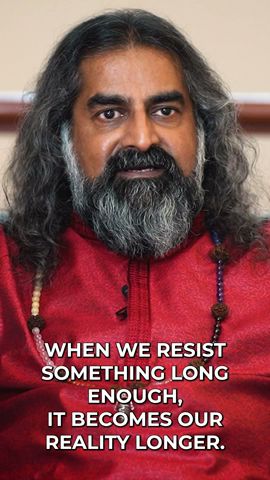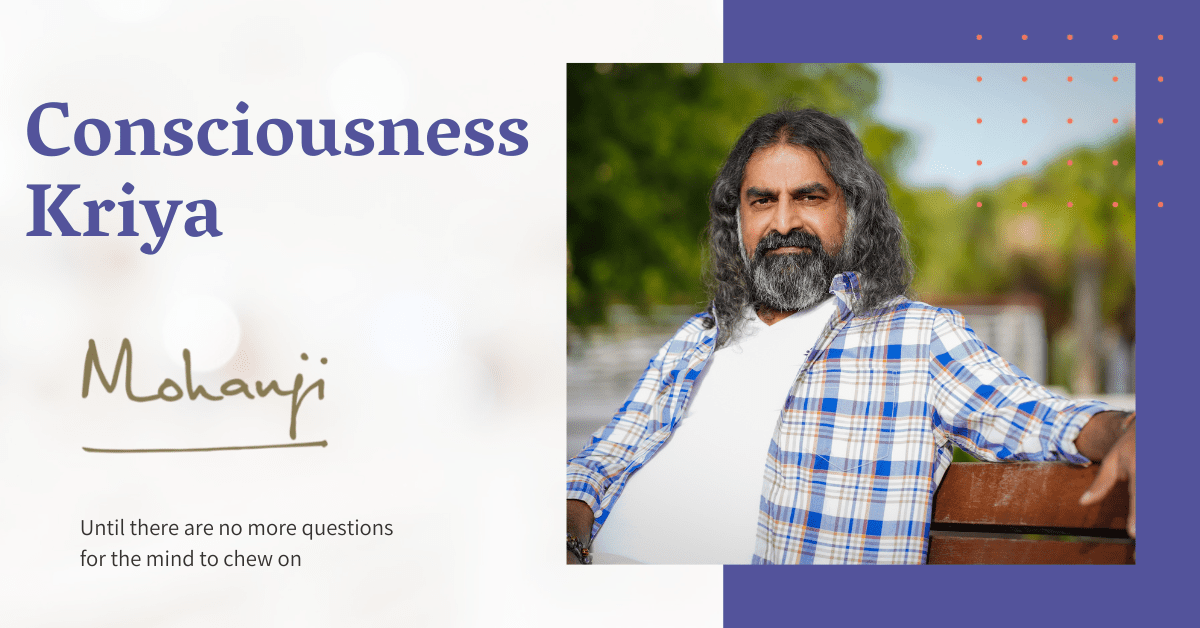How long should we practice Kriya and why? | Mohanji
When external factors are disturbing you, Kriya is your path, and you practice Kriya so much that nothing disturbs you. Then you have become Kriya.How long should you practice? You should practice until Kriya becomes you. Your breathing changes – breath pattern changes, or in other words, the outside world stops influencing you. Until then, you practice Kriya. Then you are Kriya.
A tiger behaves like a tiger its entire life. It doesn’t decide to become another person. A cow behaves like a cow its entire life. Human beings – we have intelligence, we have imagination, so we become all creators. What are we creating every day? Our own realities. In other words, karma. How is karma created? I’m telling you in a simple format, so remember these things.
How is karma created? Through ownership of action. If every action is surrendered, you can’t create karma. If actions have ownership, then comes karma. “I’m doing it.” “I am”, “I am”, “I”, “I”, “I” everywhere. That’s where karma comes in. So, when we have this privilege of being independent of instinct, we also have the privilege of connecting to the source. We can connect to the source. How do you connect to the source? We should detach from our personality – addiction to the personality. We are addicted to our personalities. We take a step backwards or take a step sideways from the personality. Then you start experiencing consciousness.
Kriya and inner silence:
When you practice Kriya, usually, what happens is that you enter into deeper levels of silence inside. When you enter deeper levels of silence, you start experiencing freedom – freedom from compulsive thinking. We are thinking compulsively. We are programmed to think. That changes. That changes to ‘no need to think.’ Freedom starts there. That leads to detachment from many things outside. Imagine you don’t have to say anything in a place. People are talking; people are making sounds, but you are unaffected. You don’t have to actually participate in that whole sound. How will you feel? Relief, right? That’s one of the first things you experience with Kriya.
When you are stabilizing in Kriya, you’ll start experiencing relief because you’ll say, “I don’t have to participate in this. No problem.” Every time you don’t have to speak. But we are compulsively speaking because that’s our programming. We think we have to speak each time; we have to respond each time and react each time. That’s not true. Many times, there’s nothing to say. You don’t have to say anything. So, what happens then? More stability – you are stable.

Gaining stability through Kriya:
Kriya stabilizes all the chakras. Stability is connected to root chakra. Instability is connected to a disturbed root chakra. Chakra is just like a fan. It’s functioning by itself. But what functions it – the energy that blocks it or functions it? That’s our emotion, ownership of action. Otherwise, chakras are chakras, just like your spine. But it’s in the ether level, that’s all – ether layer. It doesn’t get affected easily. It gets affected only because you are intervening in it, interfering in it with your emotions, notions, your concepts, and prejudices. All these things affect the movement of energy. Otherwise, the energy is moving.
With Kriya, you’ll stop affecting your system because emotions are far away. If emotions are happening, expectations are happening. They are coming and going, but you’re not touching them; you’re not holding them. Let them come and go. Let emotions happen. Let them come and go through you because sometimes habit is hard to die. Habits don’t die easy, you know? They keep reminding you, “Hey, look here, something is wrong. Your habit is not functioning.”
So, you go back to the habit. Not easy for it to die, but when you think, “Okay, let it happen. We can sleep together, live together.” It stops affecting you, right? Kriya increases acceptance. Through acceptance, you overcome it. Through resistance, you retain it. Do you understand the difference here? The alignment happens automatically through Kriya.

Consistency is the key:
Kriya should be practised as much as possible in a day until such time when your whole thing is Kriya. Then, there’s no practice outside of you. You are Kriya. That means you are in the mode of a Yogi. You are in that mode – always in that Kriya state. So, until then, keep focusing and practising. Discipline and determination – these two things are essential. Two D’s; remember these. This you need to have – discipline and determination. Whether it’s night or day, whether it’s cold or heat, you should practice. Then is that oath of Kriya. You learn that oath in which the main thing is gratitude.
Remember one thing very clearly; we are here. The earth is a host, and the entire environment – nature is what the earth has offered us to experience. It’s like the host is giving you food on the table, providing you with food. The host, earth, has provided. Imagine you are in somebody’s house. The host is providing you with food. You can eat the food. That’s why you were given it. You can experience everything from what’s available. We experience it, and then we leave here after a while. A guest doesn’t stay there forever.
We depart; we go, and we’ve used whatever we’ve used, and we are grateful for all this. With that attitude, if you live, if you practice Kriya, it’ll have a tremendous effect – that we are guests here on earth. Kriya is our nature; this is the way normally we can elevate to higher awareness, and we are not disturbing anything.
Ahimsa is a very prime principle in Kriya. Imagine you are breaking all the pottery and the utensils in the house of the host, or you are leaving the whole place dirty. You’ve got a big price to pay, right? So, that’s exactly like that. What should you do? You should not disturb things. Keep everything tidy and neat; have a conscious existence. Then, you practice Kriya. So, this conscious existence plus Kriya raises you to higher levels of awareness.
Transcribed by Ilinka Regodic
Proofread by Yogesh Pandit

